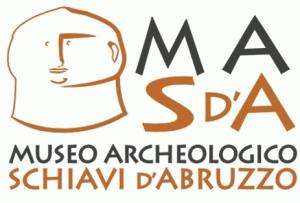The excavations
The sacred area of the “templi Italici” rises at about 3 kilometers away from the modern residential area, on a terrain built at 1000 meters above sea level, with beautiful views towards the underlying valley and the Molisan hills.
The area, defined by a polygonal wall and the remains of a medieval tower, was brought back to light in its greatest splendor between 1964 and 1974.
Inside the area, it is possible to visit the remains of the two sannite temples (one of the two is well preserved), and several other remains, such as a masonry altar. It is estimated that the remains date back to the beginning of the 2nd century B.C. and that it has been an active place of worship until the 2nd century A.D..
Today many of the findings can be seen inside the Archaeological Museum of Schiavi D’Abruzzo (MASdA), located in the historical center of the town.
Il Museo

The Archaeological Museum of Schiavi D’Abruzzo, in province of Chieti, is dedicated to one of the most important – and best preserved – sacred places of worship used by the italian population of the “Sanniti Pentri”, who built the temples starting from the 2nd century B.C..
Located in the historical center of the town, the Museum the outcome of a collaboration between the Superintendency of Archeology for Abruzzo, the District of Schiavi D’Abruzzo, the Province of Chieti and the Parsifal Cooperative Company.
The two temples in the Sacred Area are located at about 1000 meters above sea level, and are extremely interesting for the history of the Etruscan-Italian architecture, for both the articolation of the parts and the terra-cotta anatomical votives surfaced from the archaeological researches. In the sacred area che cultural activity seems to go on without any interruption from the Ellenic age, until the beginning of the 14th century, when the site was buried by a landslide. Another sacred site nearby is a Necropolis, who has, until now, given back burial remains that date back to the period between the 11th century B.C. to the 5th century A.D.
The museum drives the visitor through a ring-shaped path which examines in depth the two main themes: the Sacred Area, with an analysis of the architectural solutions adopted in the two temples and the rituals linked to them; the burials and the funerary rites, with the rich grave goods from the First Imperial Age found in the graves of the nearby Necropolis.
The exposition was organized with a didactic finality, by using various forms of language, which play with colours, sounds, light and images. A large space is dedicated to the tridimensional installations aimed to explain directly to the visitor some of the most relevant themes treated in the museum set-up.







